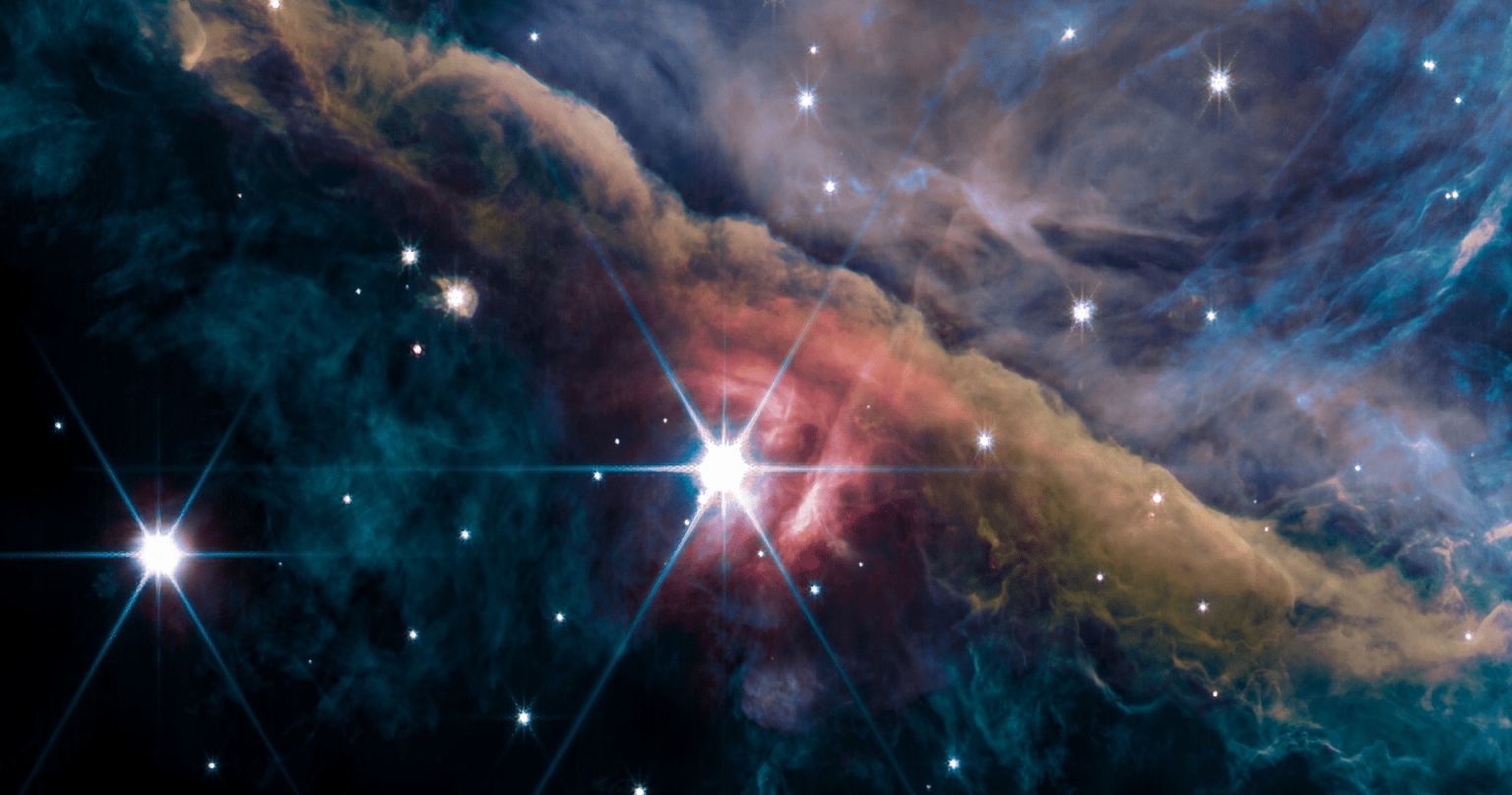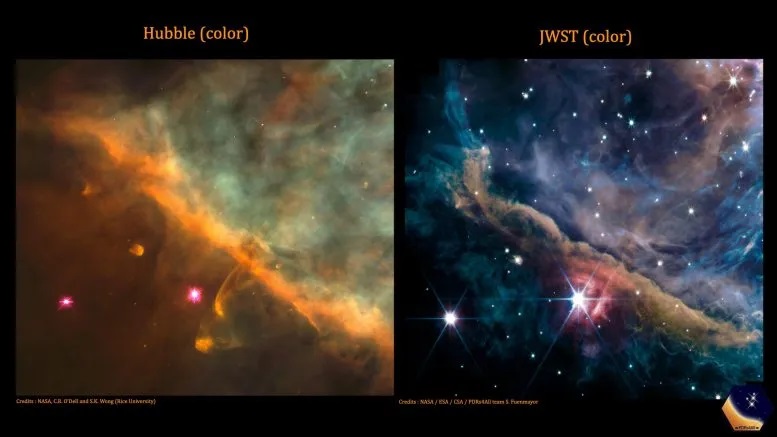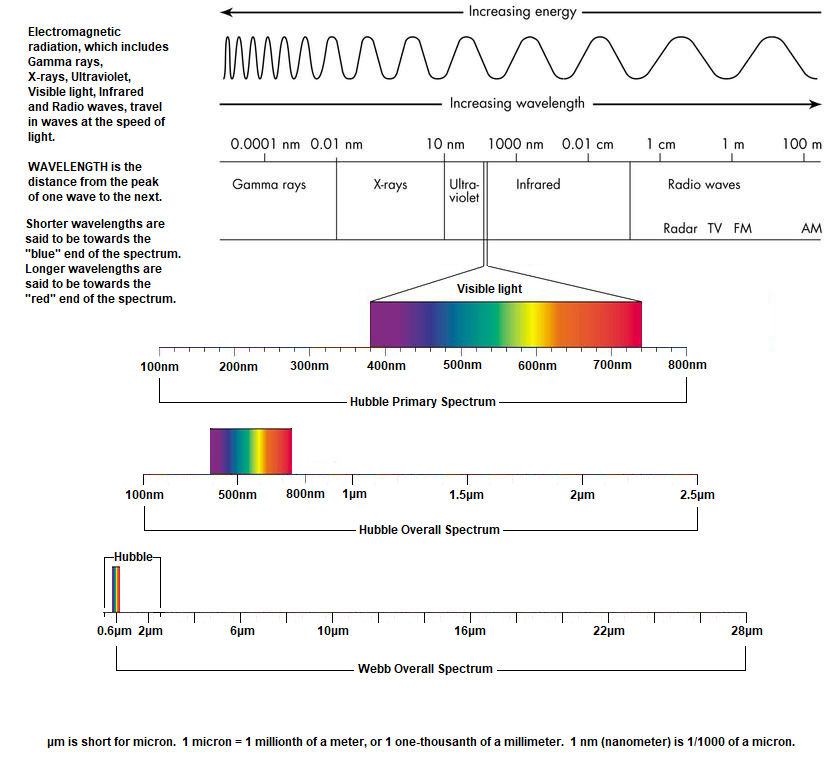It looks like you're using an Ad Blocker.
Please white-list or disable AboveTopSecret.com in your ad-blocking tool.
Thank you.
Some features of ATS will be disabled while you continue to use an ad-blocker.
share:
The image was taken as part of Webb's Early Release Science program , researchers wanted to take a closer look at the Orion Nebula so they did and
this is what they saw.

Comparison of the Webb image and Hubble's image.

Still waiting for the Trappist system but sweeties like this are always welcome , it's like a cosmic Eagle swooping through space.

The inner region of the Orion Nebula as seen by the James Webb Space Telescope’s NIRCam instrument. This is a composite image from several filters that represents emissions from ionized gas, molecular gas, hydrocarbons, dust, and scattered starlight. Most prominent is the Orion Bar, a wall of dense gas and dust that runs from the top left to the bottom right in this image, and that contains the bright star θ2 Orionis A. The scene is illuminated by a group of hot, young massive stars (known as the Trapezium Cluster) which is located just off the top right of the image. The strong and harsh ultraviolet radiation of the Trapezium cluster creates a hot, ionized environment in the upper right, and slowly erodes the Orion Bar away. Molecules and dust can survive longer in the shielded environment offered by the dense Bar, but the surge of stellar energy sculpts a region that displays an incredible richness of filaments, globules, young stars with disks and cavities. Credit: NASA, ESA, CSA, Data reduction and analysis: PDRs4All ERS Team; graphical processing S. Fuenmayor
Comparison of the Webb image and Hubble's image.

Orion Nebula: JWST versus Hubble Space Telescope (HST): The inner region of the Orion Nebula as seen by both the Hubble Space Telescope (left) and the James Webb Space Telescope (right). The HST image is dominated by emission from hot ionized gas, highlighting the side of the Orion Bar which is facing the Trapezium Cluster (off the top right of the image). The JWST image also shows the cooler molecular material that is slightly further away from the Trapezium Cluster (compare the location of the Orion Bar relative to the bright star θ2 Orionis A for example). Webb’s sensitive infrared vision can furthermore peer through thick
scitechdaily.com...
Still waiting for the Trappist system but sweeties like this are always welcome , it's like a cosmic Eagle swooping through space.
Anyone else see the skull (top right) in the comparison images??
a reply to: scraedtosleep
makes you wonder if things are closer than they think, still light years away but closer
measurements can only be as good as the tools you used to measure it, and if the Hubble was up until very recently used as the yard stick so to speak, yikes....
the difference in the red to blue shift makes it look like the nebula is coming right at us super fast, also notice how there are no gas clouds in front of the two stars in the JST shot and they are behind in the Hubble. I'm sure it is just some odd perspective shifting o4r some form of parallax
i wish i could go to these places we are seeing in these images but that will never happen.
makes you wonder if things are closer than they think, still light years away but closer
measurements can only be as good as the tools you used to measure it, and if the Hubble was up until very recently used as the yard stick so to speak, yikes....
the difference in the red to blue shift makes it look like the nebula is coming right at us super fast, also notice how there are no gas clouds in front of the two stars in the JST shot and they are behind in the Hubble. I'm sure it is just some odd perspective shifting o4r some form of parallax
i wish i could go to these places we are seeing in these images but that will never happen.
Where are the attack ships?
Nevertheless, we are lucky to see such beauty this close... : )
Roy Batty: I've seen things you people wouldn't believe. Attack ships on fire off the shoulder of Orion. I watched C-beams glitter in the dark near the Tannhauser gate. All those moments will be lost in time...
Nevertheless, we are lucky to see such beauty this close... : )
originally posted by: gortex
a reply to: fishingmd84
I have a feeling that's probably down to Hubble.
I have a feeling that's probably down to humans.
a reply to: fishingmd84
Webb and Hubble observe different wavelengths of light and there is post processing involved.
www.axios.com...
Webb and Hubble observe different wavelengths of light and there is post processing involved.
www.axios.com...
edit on 15-9-2022 by LevelHeaded because: Added
source
That is awesome ive seen it through telescopes several times but that does not do it justice.
a reply to: LevelHeaded
This post explains the Red/Blue shifting. I'm sure any measurements that were taken using hubble was done using raw data and not using the highly altered images that we, the public, receive. MOST images that we receive have been post-processed so that we can ooh and ahh at them, as the raw images are usually very dull. Here is a link that explains the process.
Resource Mag Online Linkypoo
This post explains the Red/Blue shifting. I'm sure any measurements that were taken using hubble was done using raw data and not using the highly altered images that we, the public, receive. MOST images that we receive have been post-processed so that we can ooh and ahh at them, as the raw images are usually very dull. Here is a link that explains the process.
Resource Mag Online Linkypoo
originally posted by: fishingmd84
a reply to: gortex
its interesting the two stars in the foreground in the Hubble shot are heavily red shifted but in the JWT they are highly blue shifted.
wonder if it is an aberration of Hubble.
originally posted by: fishingmd84
a reply to: frogs453
but it should still be red shifter and even more so if it is IR light being picked up
i just find it interesting that things look so much different.
guess it is all about the equipment
You are correct - It is about the equipment.
Before I explain, I should point out that "red shifted" and "blue shifted" are not quite the right terms to use. "______ shifted" in astronomy specifically refers to spectral lines that appear at a higher or lower wavelength than they normally would in a lab. This is usually due to the Doppler effect, but there can be other causes. It may sound less "techie", but it is more accurate to say that the star "looks redder" in the Hubble image and "looks bluer" in the Webb image.
Yeah, I'm totally nit-picking. Forgive me - I know what you mean.
Now then, I took a diagram from this website and modified it to show the Hubble and Webb's capabilities and compare the two:

As you can see, Hubble is mostly a visible light instrument, but it can see a bit into the ultraviolet and infrared. Webb's vision starts in the red part of the visible light spectrum and goes way into the infrared.
Keep in mind that these are frequencies that our human eyeballs cannot see. If they showed us a picture of what the Webb actually sees, the image would be mostly black to our eyes, except for stars that would appear very red. When they process a Webb image like in the OP, they compress its spectrum from 27,400nm wide down to ~360nm, and shift it (there's that damned word again ) into our visible light spectrum. They do similar processing with the Hubble images.
Now, let's take that star you're asking about - θ2 Orionis A - and suppose that its brightness peaks at around 2 microns (2μm). On a processed Hubble image, 2μm is towards the red end of its spectrum, but on a Webb image, 2μm is towards the blue end of its spectrum. That's why it "looks bluer" in the Webb image than the Hubble.
I hope this helps.
edit on 16-9-2022 by Saint Exupery because: I fixed a typo.
a reply to: Saint Exupery
that's why i said the change of red stars from the Hubble changing to blue seemed to me if it were a true doppler shift in the spectrum than it would mean they are coming closer.
Hubble is great but it went up messed up and had to be jerry rigged during spacewalks to fix the mirror so i don't expect it to be 100% correct.
Hubble also sees in the to IR but obviously not as deep as JWT so just the fact it can see past the gas and dust might change the spectra of light coming from the star
but good info.
I'm surprised we haven't found and previously red shifted(far away) stars start coming closer to us and the doppler shift makes it seem doppler shifted to blue(closer).
that's why i said the change of red stars from the Hubble changing to blue seemed to me if it were a true doppler shift in the spectrum than it would mean they are coming closer.
Hubble is great but it went up messed up and had to be jerry rigged during spacewalks to fix the mirror so i don't expect it to be 100% correct.
Hubble also sees in the to IR but obviously not as deep as JWT so just the fact it can see past the gas and dust might change the spectra of light coming from the star
but good info.
I'm surprised we haven't found and previously red shifted(far away) stars start coming closer to us and the doppler shift makes it seem doppler shifted to blue(closer).
edit on 16-9-2022 by fishingmd84 because: .
a reply to: fishingmd84
Remember that Doppler shift is not just about color. It's a shift of the lines in the spectrum. Let's look at the spectrum of hydrogen: If we measure the spectrum in a lab, the H-alpha line will be at 656.3nm. With zero radial velocity from us, a hot blue star's H-alpha line will be at 656.3nm, and a cool red star's H-alpha line will be at 656.3nm. If the blue star cools off, the color will become redder, but the H-alpha line will stay at 656.3nm. If the star moves away from us at ~300km/sec, the light will be slightly redder, and the H-alpha line will move over to 657nm. (Actually, we work it the other way around: If the star's peak intensity starts drifting towards the red, but the H-alpha line doesn't move from 656.3nm, we know that it is cooling-off).
If you measure the spectral lines of θ2 Orionis A (or any other star, for that matter) with both the Hubble and the Webb, the lines will be at identical frequencies.
Remember that Doppler shift is not just about color. It's a shift of the lines in the spectrum. Let's look at the spectrum of hydrogen: If we measure the spectrum in a lab, the H-alpha line will be at 656.3nm. With zero radial velocity from us, a hot blue star's H-alpha line will be at 656.3nm, and a cool red star's H-alpha line will be at 656.3nm. If the blue star cools off, the color will become redder, but the H-alpha line will stay at 656.3nm. If the star moves away from us at ~300km/sec, the light will be slightly redder, and the H-alpha line will move over to 657nm. (Actually, we work it the other way around: If the star's peak intensity starts drifting towards the red, but the H-alpha line doesn't move from 656.3nm, we know that it is cooling-off).
If you measure the spectral lines of θ2 Orionis A (or any other star, for that matter) with both the Hubble and the Webb, the lines will be at identical frequencies.
new topics
-
Joe Rogan conspiracy (maybe)
ATS Skunk Works: 3 hours ago -
Results of the use of the Oreshnik missile system in Dnepropetrovsk
World War Three: 5 hours ago -
Nigel Farage now the Most Favoured UK Politician
Regional Politics: 7 hours ago
top topics
-
Little Johnny and Larry should team up
General Chit Chat: 13 hours ago, 12 flags -
Results of the use of the Oreshnik missile system in Dnepropetrovsk
World War Three: 5 hours ago, 10 flags -
Nigel Farage now the Most Favoured UK Politician
Regional Politics: 7 hours ago, 4 flags -
Joe Rogan conspiracy (maybe)
ATS Skunk Works: 3 hours ago, 3 flags -
Will Us use alien technology to fight in ww3?
World War Three: 14 hours ago, 2 flags
active topics
-
Results of the use of the Oreshnik missile system in Dnepropetrovsk
World War Three • 138 • : Oldcarpy2 -
DOJ moving to wind down Trump criminal cases before he takes office
Mainstream News • 46 • : WeMustCare -
What Joe Rogan said Vs The View
Dissecting Disinformation • 23 • : cocnutcrab883 -
-@TH3WH17ERABB17- -Q- ---TIME TO SHOW THE WORLD--- -Part- --44--
Dissecting Disinformation • 3353 • : Thoughtful3 -
Nigel Farage now the Most Favoured UK Politician
Regional Politics • 7 • : NorthOS -
President-Elect TRUMP Picks Former Florida A.G. PAM BONDI to be U.S. Attorney General.
2024 Elections • 58 • : WeMustCare -
Well, here we go red lines crossed Biden gives the go ahead to use long range missiles
World War Three • 330 • : putnam6 -
Little Johnny and Larry should team up
General Chit Chat • 4 • : ColeYounger2 -
Montelukast affects brain, caused 5 year old to attempt suicide
Medical Issues & Conspiracies • 11 • : marg6043 -
President-Elect DONALD TRUMP's 2nd-Term Administration Takes Shape.
Political Ideology • 240 • : WeMustCare
